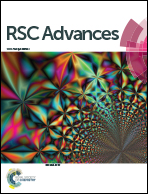A titanium dioxide/nitrogen-doped graphene quantum dot nanocomposite to mitigate cytotoxicity: synthesis, characterisation, and cell viability evaluation
Abstract
Titanium dioxide nanoparticles (TiO2 NPs) have attracted tremendous interest owing to their unique physicochemical properties. However, the cytotoxic effect of TiO2 NPs remains an obstacle for their wide-scale applications, particularly in drug delivery systems and cancer therapies. In this study, the more biocompatible nitrogen-doped graphene quantum dots (N-GQDs) were successfully incorporated onto the surface of the TiO2 NPs resulting in a N-GQDs/TiO2 nanocomposites (NCs). The effects of the nanocomposite on the viability of the breast cancer cell line (MDA-MB-231) was evaluated. The N-GQDs and N-GQDs/TiO2 NCs were synthesised using a one- and two-pot hydrothermal method, respectively while the TiO2 NPs were fabricated using microwave-assisted synthesis in the aqueous phase. The synthesised compounds were characterised using Fourier transform infrared (FTIR) spectroscopy, high-resolution transmission electron microscopy (HRTEM), field emission scanning electron microscopy (FESEM) and UV-visible spectrophotometry. The cell viability of the MDA-MB-231 cell line was determined using a CellTiter 96® AQueous One Solution Cell Proliferation (MTS) assay. The obtained results indicated that a monodispersed solution of N-GQDs with particle size 4.40 ± 1.5 nm emitted intense blue luminescence in aqueous media. The HRTEM images clearly showed that the TiO2 particles (11.46 ± 2.8 nm) are square shaped. Meanwhile, TiO2 particles were located on the 2D graphene nanosheet surface in N-GQDs/TiO2 NCs (9.16 ± 2.4 nm). N-GQDs and N-GQDs/TiO2 NCs were not toxic to the breast cancer cells at 0.1 mg mL−1 and below. At higher concentrations (0.5 and 1 mg mL−1), the nanocomposite was significantly less cytotoxic compared to the pristine TiO2. In conclusion, this nanocomposite with reduced cytotoxicity warrants further exploration as a new TiO2-based nanomaterial for biomedical applications, especially as an anti-cancer strategy.



 Please wait while we load your content...
Please wait while we load your content...